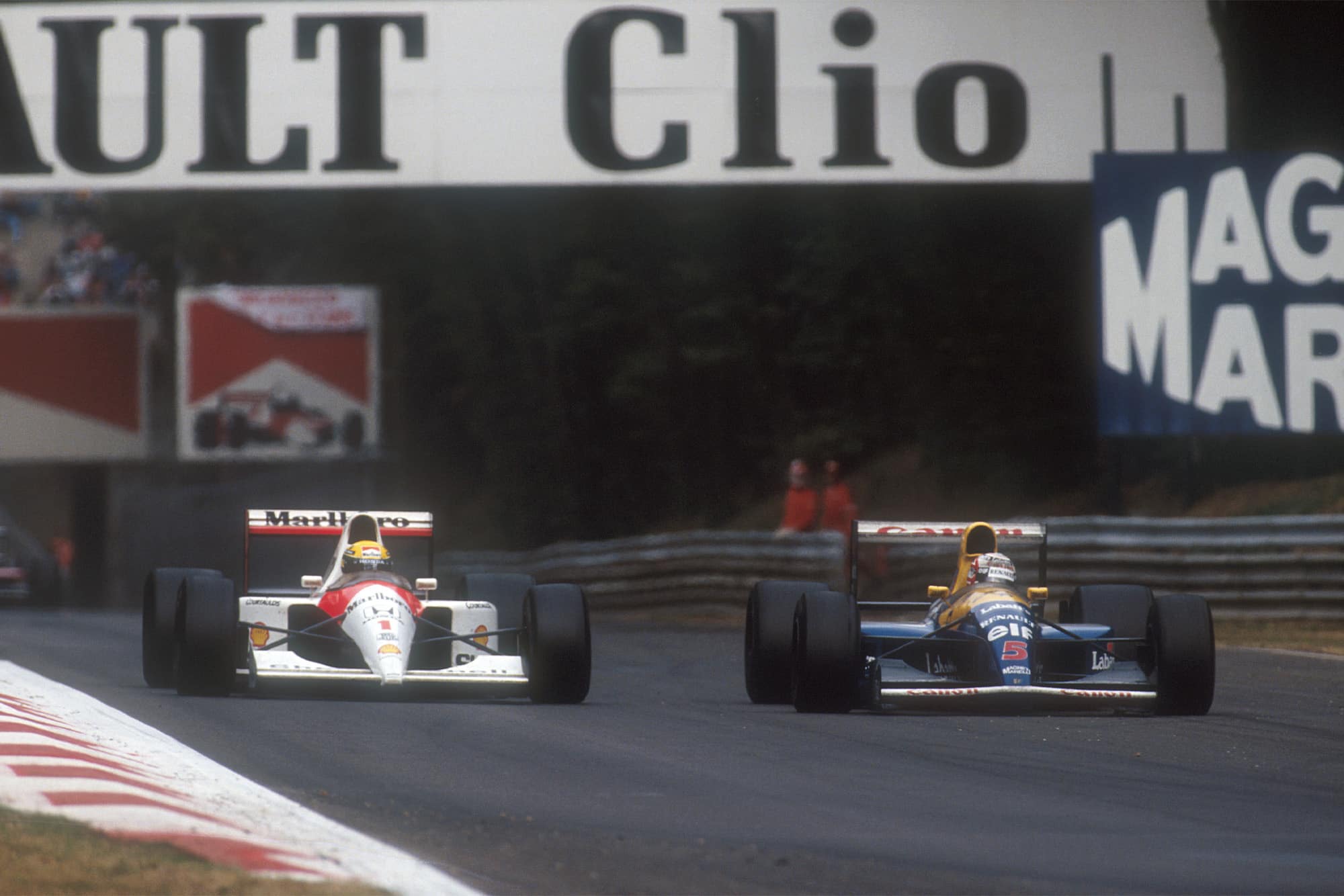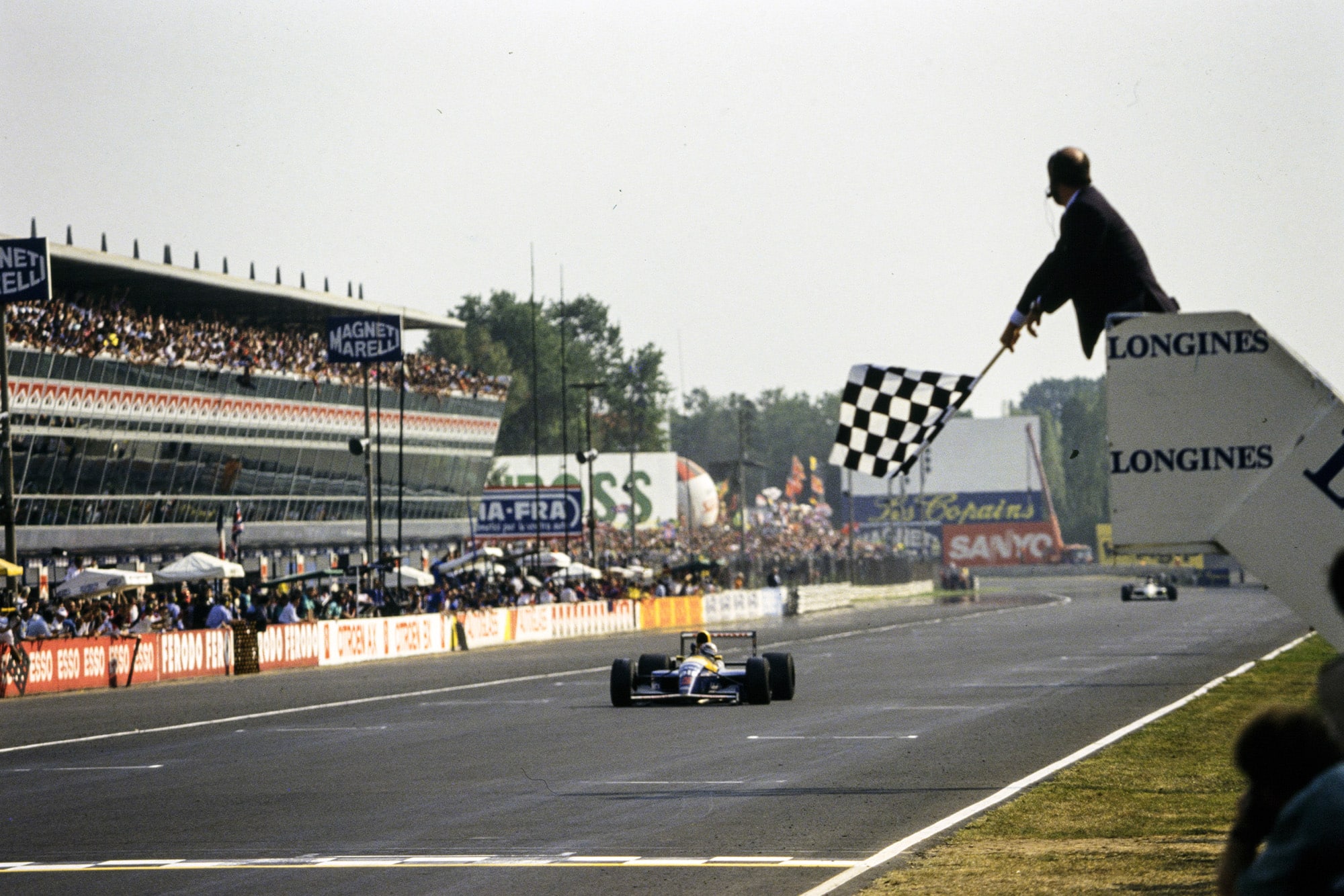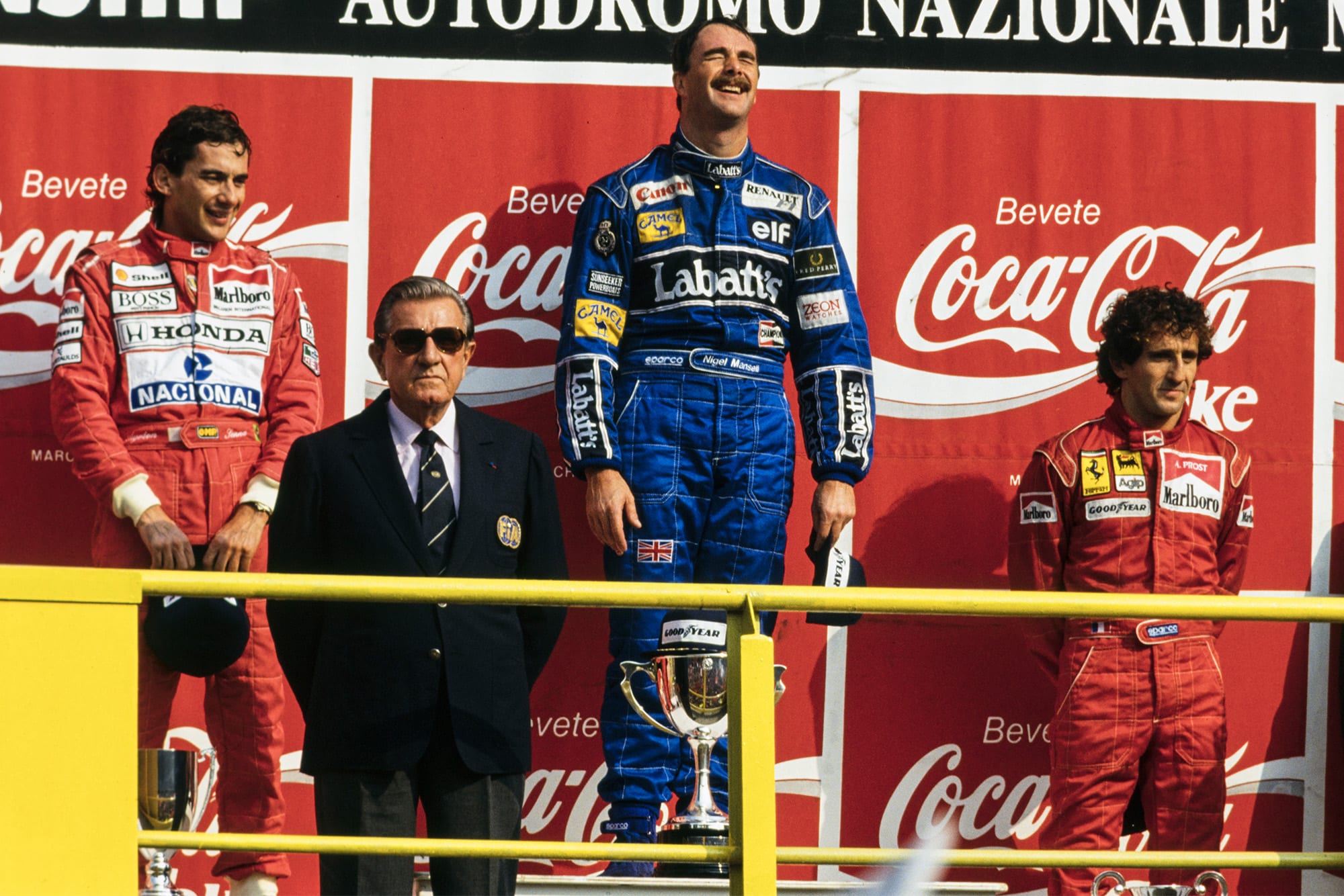Italian Grand Prix
Silence of the fans
The Italian Grand Prix and the Monza track have always been synonymous with sheer unadulterated speed, regardless of the attentions that have been made over the years, and this year’s race did not disappoint the Formula One World, even though it proved to be a total disaster for the Ferrari fans. Never have they been so quiet, their only moment of joy being when Ricardo Patrese took the lead from Senna and led for one lap, but even then the crowd’s joy was expressed by relatively polite waving, there was no ecstatic screaming and yelling and leaping up and down, and it was really out of politeness to a true Italian racing driver, in an Anglo-French car. Had he been in a Ferrari they would still be cheering!
A large crowd had turned up for the first day of practice and qualifying, ever optimistic as only Italians can be, but they all went home in a very grey state; Jean Alesi was fifth and Alain Prost was sixth after the first qualifying session, which had been particularly neat and tidy and an example of qualifying at its best, but not for the Italians. Few of them came back on Saturday and most of them probably spent a miserable afternoon in front of their television sets, as a local station guaranteed to screen every minute of the qualifying hour live.

Michael Schumacher was snapped up by Benetton after his debut at Spa
Motorsport Images
Friday morning testing time soon showed that only Williams-Renault and McLaren-Honda had a complete grip of the situation, the rest being also-rans, relatively, and the contest was going to be about engine power and efficiency, for the days of power being above all else seem to have gone. Today you need power, but in addition it must be usable power, or as the Japanese say, the engine must also have “drivability” meaning a torque spread, and no “mixture holes” in the rev range and clean unobstructed pick-up and throttle response, all of which can be achieved with electronic computerised engine-management units. The Americans would probably say that the engine must be “user friendly”. In addition, while the control unit is telling the engine and its accessories what to do, your telemetry on the car can transmit it all back to the pits where the engineers can assure themselves that all is well. The driver can get on with his driving, providing there are no orange or red lights flashing on his instrument panel.
If the engine people can do all this and also make the engine “fuel efficient” at the same time, the teams have got a head-start over the opposition. If the chassis engineers and the aerodynamic experts can produce an efficient car that has good cornering power, using the tyres to their maximum, and achieve effective aerodynamic stability with low drag losses, then the overall package can use all the engine power for acceleration and maximum speed, while an efficient engine can enable the car to start the race carrying less weight of fuel. At the moment the Williams-Renault seems to have the best overall package, and they also have two drivers who can use everything adequately, while Senna and the McLaren-Honda can match them, but Berger in the McLaren-Honda lacks that tiny bit of inspiration and magical touch; Prost and Alesi with the Ferrari can do little other than strive in vain to keep up.

Nigel Mansell and Ayrton Senna fight for the lead
Motorsport Images
Testing and qualifying for the Italian Grand Prix confirmed all the above, as a look at the starting grid will show, and in the race it was a clear case of Williams-Renault V10 versus McLaren-Honda V12, other drivers’ faults allowing Prost to claim third place, which he duly acknowledged after the race. Senna led away from the start, with Mansell hounding him, but the Brazilian looked to be well in charge of the situation as they circulated the Monza park circuit at an average speed of nearly 150mph, passing the main grandstand each time at over 195mph. As always, Monza was fast, and in addition it was furious between the McLaren-Honda V12 and the Williams-Renault V10 and the noise was glorious, the only thing missing being the frenzy of the crowd, who were sitting in the grandstand in sullen silence. Patrese was keeping his Williams closely in touch with his teammate, but once again Berger was too far back to be any help to his team-leader, but at least he was leading the Ferrari. Alesi had an excursion off the track quite soon after the start, and then made a pit stop for repairs and new tyres, so that by the time the race had sorted itself out after the first lap scuffle the Frenchman was in last place and striving in vain to make up for lost time. Boutsen in a Ligier disappeared after only one lap and Moreno spun off the track on the third lap, in his mount, car number 32 normally driven by Gachot, and driven very briefly in the Belgian GP by Schumacher.
In some complicated “big business” dealings behind closed doors and round the back of motor homes and transporters, the “wonder boy” at the Belgian GP found himself changing his Jordan-green racing overalls for the multi-coloured ones of Benetton, and Roberto Moreno found himself decked out in green. For the media, who are more interested in people and business manoeuvrings than in motor racing or racing cars, this strange situation of drivers between Jordan and Benetton seemed to be more important than the no-holds-barred clear cut racing battle between McLaren-Honda and Williams-Renault, with Prost fighting for European supremacy over Japan. From the moment Michael Schumacher got into a Benetton-Cosworth V8 he made it look as good as a Jordan-Cosworth V8, and now he was properly into his first Grand Prix he was running in a very impressive sixth place, behind Senna, Mansell, Patrese, Berger and Prost and losing very little ground to them. A young man worth watching closely. But the serious business was up at the front where the leaders were beginning to lap the tail-enders. Senna was still leading but Patrese had closed up on Mansell and the Brazilian’s mirrors were full of Williams-Renaults, at times with number 5 in one mirror and number 6 in the other. This continued for some ten laps or more and though Senna looked confident to hold them off, the feeling was that he could have used a bit of help from Berger, but the Austrian was too far back, albeit in fourth place, to do anything to help. The two Williams-Renaults were not simply hanging on to the leader, they were pushing, and pushing hard.

Mansell crosses the line to win at Monza
Motorsport Images
On lap 19 Mansell decided to take a breather and let his tyres and temperature relax a bit and he waved Patrese through into second place, to let him continue the pushing of Senna, which he did nobly and with real aggression, for after all it was his home Grand Prix and at Monza, the home of Italian motor racing. For seven laps Patrese never let up and was really leaning on Senna all the time, but the World Champion kept him at bay, until on lap 25 when Patrese out-braked the McLaren into the fast ess-bend chicane on the back of the circuit. Not many drivers can claim to have out-braked Senna anywhere, but Patrese earned himself a medal on that occasion. For one glorious lap he led the Italian GP, and he really deserved to do so but the next lap into the chicane disaster struck, when third gear did not select properly; as he turned into the corner it did so and the rear wheels locked for a fraction of a second and the car spun. In a flash Senna and Mansell were by, for the “Brit” was still close to the leader, even though he was “taking a breather”. Patrese caught the car in its spin and ended that lap in third place, but on the next lap he was gone, the transmission had failed completely. A valiant drive was over.
Mansell now returned to the fight with renewed energy, for he had never been far away, and pushed the Williams nose up under the rear aerofoil of the McLaren. At the crucial chicane on the back of the circuit Senna had his left front brake lock on, and with smoke pouring off the tyre and efficient braking on only three wheels he had to go deep into the corner before turning, and that was all that Mansell needed. The Williams was through and into the lead. The locked brake had put a “flat” on the McLaren’s left front tyre and Senna weighed up the situation immediately, and as Mansell crossed the timing line at over 195mph at the end of lap 34, to be recorded as leading the Italian GP, Senna was into the pits for a new set of Goodyears. The actual stop took less than six seconds, being a brilliant piece of work by the McLaren mechanics, but slowing to a stop and accelerating away again meant that Senna had dropped to fifth place when he was back on the track. There were 19 laps to go and Mansell had more than 12 seconds lead over Prost, when Ferrari was no challenge at all. Berger was a lonely third and Schumacher was fourth, but not for long for Senna was back up to Mansell’s pace. There was no let up, everyone was really racing still, and making their fastest laps.

Nigel Mansell exhausted on the podium
Motorsport Images
All this excitement at the front, where it really mattered, completely over-shadowed the rest of the field. Some had disappeared quietly, like Nakajima who ran off the track when his throttle slides stuck open, and Bernard pulled his Lola off onto the side when his engine failed, and Alesi who coasted into the pits with so much oil coming out of the back of his Ferrari that a marshal with a bucket of powder followed him up the pit lane as the mechanics wheeled it into the garage without a second glance — engine. Right from the start Michael Schumacher in the Benetton-Cosworth V8 was undisputably “best of the rest” and none of the “hopefuls”, “hard-triers” or “also-rans” or his three-times World Champion team-leader Nelson Piquet even saw which way he went! He drove a lonely race, but a consistent one and between laps 19 and 28 his lap times varied from 1 minute 28.1 second to 1 minute 28.8 seconds at a time when Senna was lapping at 1 minute 27.6 seconds. Of the drivers ahead of him he saw Alesi as he was extracting himself from the gravel run-off area, and Senna when he caught and passed the Benetton after his pit-stop, and no doubt took careful notes of both occasions. To finish fifth in only your second F1 race, and to do so from seventh place on the starting grid and to only be passed by the World Champion while he was making up time after an unscheduled pit-stop is probably some sort of media “record”, but it was very impressive by any standards.
To return to the race itself, Mansell never put a foot wrong and all the hi-tech “gizmos” on the Renault V10 engine and the Williams car behaved perfectly, and there are a lot of them doing important jobs. Senna was lapping two or three tenths of a second faster than Mansell but it wasn’t enough to make any serious inroads into the lead that Mansell had. Senna passed Schumacher’s Benetton on lap 37, Berger’s McLaren on lap 41 and Prost’s Ferrari on lap 46 and at the end of the 53 laps he was still short of victory by 16.2 seconds, which means a lifetime by modern Grand Prix standards. As Senna eased off for the last lap, admitting defeat by Mansell and the Williams-Renault V10, the McLaren-Honda V12 was not disgraced, for Senna put in the fastest lap with a time of 1.26.061, an average of 150.756mph, while Mansell’s race average was 147.109mph, both these performances establishing new records, as it had Senna’s pole-position lap established on Friday afternoon when he recorded 1.21.114s, an average of 159.951mph. Monza retaining its characteristic of being fast, and this year it was particularly furious, right to the end. Even those who had not figured near the front were a bit breathless at the finish, Piquet finishing sixth in the second Benetton after a spin and a pit stop for new Pirellis. Just out of the real money was de Cesaris who ran through non-stop to finish a few seconds behind Piquet, and then came Capelli in the V10 Ilmor-powered Leyton House, the engine proving reliable for once. The two Brabham-Yamahas ran fast and reliably, but lost a lot of time with pit stops for new Pirelli tyres, and last car to be classified was the Lamborghini V12-powered Lambo 2 of Larini. — DSJ
***
Results (top five), Italian GP, Monza, September 8th
53 laps of 5.800 km circuit (307.400 kms; 191.009 miles)
1.. Nigel Mansell, GB, (Williams FW14 – Renault V10) 1h 17m 54.319s
2. Ayrton Senna, BRA, (McLaren MP4/6 – Honda V12) 1h 18m 10.581s
3. Alain Prost, F, Ferrari 643 – Ferrari V12) 1h 18m 11.148s
4. Gerhard Berger, AUT, (McLaren MP4/6 – Honda V12) 1h 18m 22.038s
5. Michael Schumacher, D, (Benetton B191 – Cosworth V8 EXP) 1h 18m 28.782s
Conditions: Hot and hazy
Winner’s Average Speed: 236.749 kph (147.109 mph)
Fastest Lap: Ayrton Senna (McLaren MP4/6 – Honda V12) 1m 26.061s on lap 41: 242.619 kph (150.756 mph)
